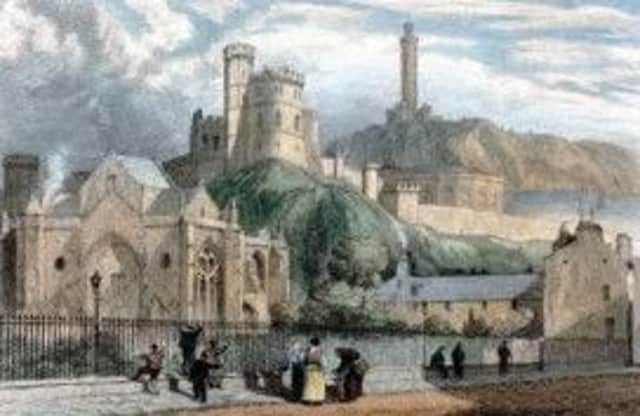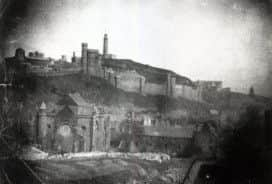Lost Edinburgh: Trinity College Church
This article contains affiliate links. We may earn a small commission on items purchased through this article, but that does not affect our editorial judgement.


Trinity College Church and its adjoining hospital were founded by Mary of Gueldres, consort to King James II, in 1460. The impressive medieval kirk was situated close to present day Calton Road in the valley below Calton Hill. Work on the church continued until the 1530s although it would never be 100% complete. Following the Scottish Reformation in 1560, the ownership of Trinity College Church was passed over to the town council – a decision that would prove costly three centuries later.
In 1848 the North British Railway Company purchased the site in order to expand Waverley Station. The plans sadly involved the removal of all original buildings including the historic Trinity College Church and the former hospital. However, a condition was set which stated that the church must be disassembled stone by stone and rebuilt elsewhere. The stones which made up the church were carefully dismantled, numbered and deposited on Calton Hill under the strict supervision of Edinburgh architect David Bryce. The remains of Queen Mary, the church’s foundress, had been interred within the church since 1463 and were now moved to Holyrood Abbey. Incredibly, pioneer photographers Hill & Adamson managed to take a number of calotypes of the old kirk before its demise. The “scandalous desecration” of the ancient church and hospital incensed Lord Henry Cockburn who fumed: “It was not only the oldest, but almost the only remaining Gothic structure in Edinburgh; and those who understood the subject, revered it as one of great architectural interest. Though never completed, what was of it was quite entire; in so much that a congregation met in it. The presence of such a building honours a city. Yet this church was sacrificed, not to the necessities, but to the mere convenience of a railway. The railway had been finished and was in action. But it wanted a few yards of more room for its station, and these it got by the destruction of the finest piece of old architecture in Edinburgh.”
Advertisement
Hide AdDue to a series of arguments, legal wrangles and lack of finance twenty-five years would pass before a decision was made on where to rebuild the kirk. The £16,000 that the town council received from the North British Railway Company had been intended to be used to rebuild Trinity Church, but it had been mysteriously spent elsewhere. The construction of a new Trinity Church eventually began on Jeffrey Street in 1872. Unfortunately, the numbered stones were considerably depleted having lain unprotected on Calton Hill for so many years. Many Edinburgh citizens had simply helped themselves and good number of what remained were badly damaged. In the end, barely enough stones to rebuild a small portion of the original church were salvaged.


Today the new church on Jeffrey Street is no more. It was demolished in 1964 but a small section known as the Trinity College Apse (formerly the Brass Rubbing Centre) still survives on Chalmers Close behind modern-day Jurys Inn. Many of the painted numbers on the stonework from when the original church was dismantled can still be seen. The remaining structure is protected by Historic Scotland as a Category A listed building.
• David McLean is the creator of the Lost Edinburgh Facebook page
SEE ALSO: